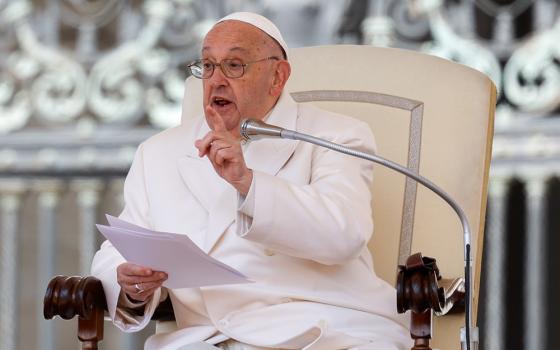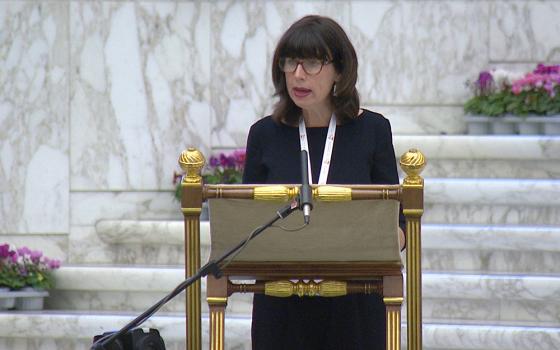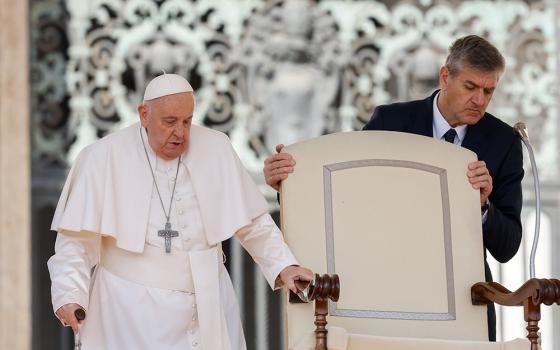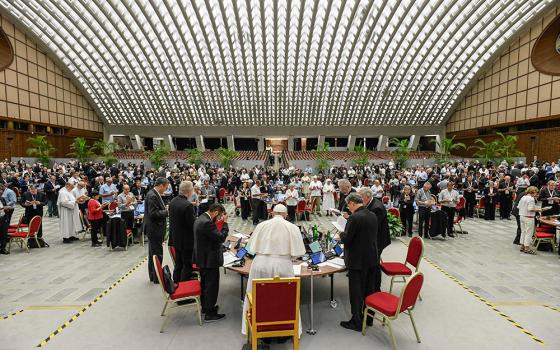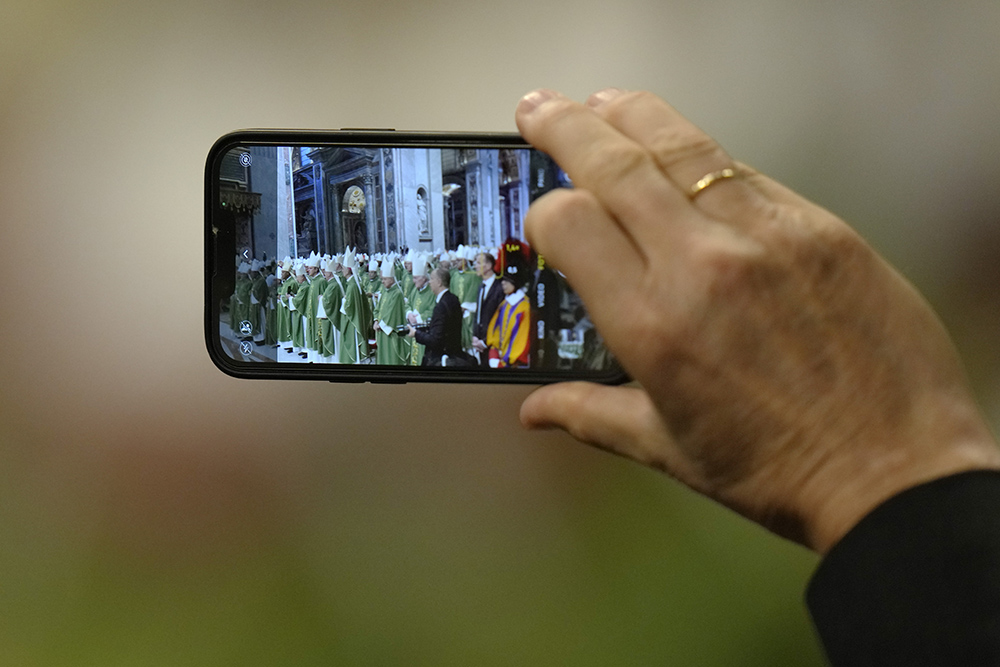
A person uses a smartphone to film as Pope Francis presides over a Mass for the closing of the first session of the synod on synodality in St. Peter's Basilica at the Vatican Oct. 29. (AP/Alessandra Tarantino)
What now? The first session of the two-year synod in Rome has finished its work and published a final document. It offers ideas to guide the church in the next 11 months before the second session gathers in Rome next autumn. What does the task look like for the church here in the United States?
The final document has some very specific proposals, and the section on formation especially has some clues about how to proceed.
The text gives us the model for formation. "The way in which Jesus formed the disciples constitutes the model we need to follow. He did not merely impart teaching but he shared his life with them," the document states. "Through the example of his own prayer, he drew from them the request: 'Teach us to pray.' By feeding the crowds, he taught them not to dismiss the needy. By walking to Jerusalem, he showed the way to the Cross." None of that is easy.
In our busy world, making time to pray is a challenge. It requires us all, from bishop to "C&E Catholics," to be willing to be taught. In our self-centered, consumerized culture, showing people the way to the cross is never easy. It is impossible unless we encounter with compassion those whose crosses are many or especially burdensome, and learn from them.
The document makes clear that formation is not just for the ordained, nor something done only on Sunday at Mass.
Advertisement
"The Holy People of God is not only the object but is first and foremost the co-responsible subject of formation. The first formation, in fact, takes place in the family," the text states.
Here is something we must learn from our Jewish brothers and sisters, for whom the family, not the synagogue, has always been the primary locus of faith formation.
The proposals contain a great deal of focus on the formation of candidates for ordained ministry, and that is certainly needed. But it starts with a specifically synodal note: "We propose that priority should be given to providing programmes designed and intended for the joint formation of the entire People of God (laity, consecrated and ordained ministers)," the text states. "Dioceses should endeavor to encourage these projects within the local Church."
That is not necessarily a long-term proposal but it behooves the local churches to find ways to make "joint formation" part of the process of receiving the results of the first session of the synod and helping to prepare for the second.
The U.S. bishops' conference should focus on this question: What can we, as bishops, do in the next 11 months to advance the synodal discussion?
This must start in the U.S. with the bishops themselves. Evidently, there was a good deal of discussion within the aula about the role of bishops in the synodal process. Each local bishop was responsible for the synodal process within his own diocese, and there were pronounced differences in the level of engagement by the bishops from one diocese to the next.
In some countries, after the national synthesis was created, the bishops of the country gathered to reflect together on the text. They did so again after the continental synthesis was drafted. Nothing like that happened in the U.S. — or in many other countries.
That has to change. Starting later this month, at the U.S. Conference of Catholic Bishops' plenary in Baltimore, the bishops should set aside ample time to discuss this next text from the first session of the synod in Rome.
The document issued at the end of the first session is divided into sections that set forth what was discussed, points of convergence, areas for further consideration and concrete proposals. It is quite accessible. There is no reason the bishops should not clear part of their agenda in Baltimore to engage this text fully and share ideas about how they can bring this text to the people in their diocese.
Bishops, as pastors, must learn to listen, and not just once a year in Rome. The people of God need to step up to the plate, embrace their status as baptized Christians.
In the section that specifically considers the role of bishops in a synodal church, the document states:
The bishop has an indispensable role in vivifying and animating the synodal process in the local Church, promoting the mutuality between "all, some and one." The "one" Episcopal ministry values the participation of "all" the faithful, through the contribution of "some" who are more directly involved in discernment and decision-making processes. The conviction with which the bishop himself adopts a synodal approach and the style by which he exercises authority will influence decisively how priests and deacons, lay men and women, and those in consecrated life, participate in the synodal process. The bishop is called to be an example of synodality for all.
Sadly, the proposals that conclude that section are somewhat vague. They focus on the need to erect particular structures not yet determined, and the method for recommending new bishops, all of which is important. There was little in the way of concrete guidance. The U.S. bishops' conference should focus on this question: What can we, as bishops, do in the next 11 months to advance the synodal discussion just concluded?
A key to implementing synodality as a means of moving forward as a church is found in the recent post-Communion address delivered by Archbishop George Leo Thomas at the Mass erecting Las Vegas as an archdiocese and at which Cardinal Christophe Pierre, the apostolic nuncio, imposed the pallium on Thomas.
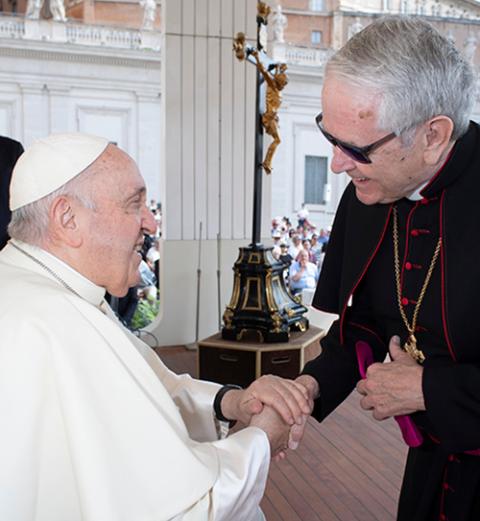
Las Vegas Archbishop George Thomas greets Pope Francis at the end of the pope's weekly general audience June 28 in St. Peter's Square at the Vatican. (CNS/Vatican Media)
Discussing the pope's reforms and synodality in particular, the new archbishop said:
As you observe the leadership style of Pope Francis, you will quickly note his preference for dialogue over diatribe, persuasion over polemic, invitation over invective and accompaniment over alienation, a style of leadership that pays high dividends in our highly polarized and contentious world. This, and so much more, is the Holy Father we know and love.
How preferable this "leadership style" is to the culture war divisiveness that too often keeps the church in a rut! And synodality is key to that style.
Another key came in something Chicago Cardinal Blase Cupich said in an interview at America magazine.
"I have said before that the bishops of the Second Vatican Council only brought back the decisions. They never shared with us the experience or replicated it," Cupich said. "I think we have an opportunity now to replicate the experience we've had here in the next 11 months, then to come back and be able to share what it is that the people of God had said to us when they have experienced a synodal process the way we did."
This is not a managerial change. It is a change in the church's self-understanding. Bishops, as pastors, must learn to listen, and not just once a year in Rome. The people of God need to step up to the plate, embrace their status as baptized Christians who are co-responsible for the church.
The role of the clergy and religious in the synodal process is akin to that in other aspects of the church's ministry, to be leaders in their communities, encouraging, listening, forming, challenging. The results will not be witnessed overnight, but it is remarkable that virtually everyone who engages in the synodal process comes away feeling good about it.
Here in the U.S., we have the opportunity to find in the synodal process a better way to carry out the church's mission. It will take effort. It will take patience. But if anything is clear after the close of the two-year process of consultation and last month's meeting in Rome, synodality is now the only game in town.




